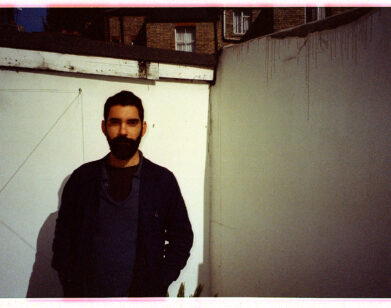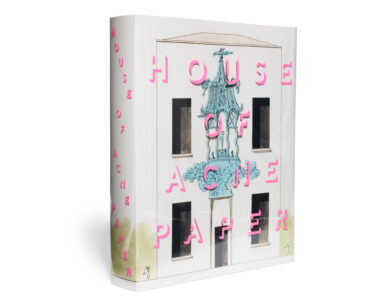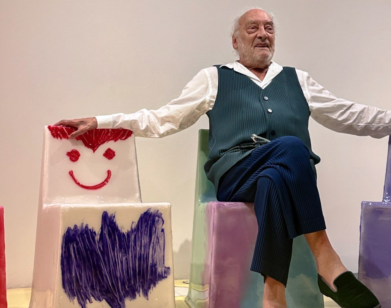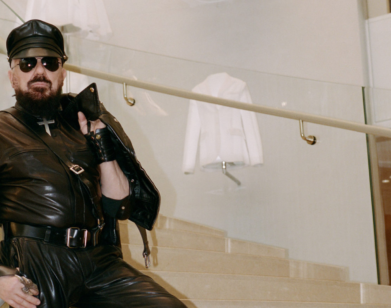At Concrete, OMA’s first building in Dubai, an ode to a disappearing valley
On Friday afternoons, for a brief spell—sometimes 45 minutes, or an hour—a spattering of priests and activists and locals from the Palestinian town of Beit Jala gather in the Cremisan Valley, one of the last green spaces in Bethlehem. Once dotted with ancient olive groves, this steep and fecund basin—which runs along the seam line between the West Bank and Jerusalem—is now partially spliced by an extension of Israel’s separation barrier. Despite protests and court rulings and lobbying by EU delegations and the Vatican, the 12-meter high wall will soon cut the valley up like butter.
The gatherings began as an outdoor mass by the local monastery: a peaceful means to protest the coming of more military jeeps. In time, atheists and people of other faiths joined them, and the assemblies morphed into non-denominational meditations on community, on urbanism, on man’s contempt for nature, on the desire to own it. They meet at 5 P.M. Soon after, the sun evaporates, the group disbands, and the valley turns black.
“While We Wait,” an immersive, multisensory installation by Bethlehem-based architects Elias and Yousef Anastas, is an ode to vanishing spaces like this. It has travelled from London’s V&A—where it was first commissioned for London Design Festival this September—to Dubai’s OMA jewel Concrete, a glittering warehouse in the sprawling Alserkal Avenue arts hub. Anastas’ work includes film and stills by Mikaela Burstow and a Tareq Abboushi soundscape, and, most significantly, a freestanding tower made from stone, one that takes on a certain mysticism in the context of Dubai’s overweening skyscrapers. This pale, opaque structure originates from nature; it is fabricated robotically but cut by hand. Every bit of its lattice-like stacked stone was quarried in Palestine. It is big enough to stand under, or to kneel and say a quiet prayer. After Dubai, the brothers will return it to the valley, near the monastery, where it will become part of the terrain.
There’s an essay by Karim Kattan accompanying this installation; in the cool and cavernous space that is Concrete, he reads it aloud in a video. You hear it on entry, before it fades into sound grabs that hark to the Cremisan. “While We Wait’s” stone tower, he writes, is more than delusional nativism, or a straight-up refusal of progress. “Palestinians know better than most that to preserve is not to enclose objects in hermetic capsules, choking the life out of them, rather, it is to reactivate spaces that are in danger of desolation, to hand them back to life.”
LAURA BANNISTER: Before we speak about “While We Wait,” I’d like to talk about Cremisan Valley, the final resting place of the sculpture. How would you describe it to someone who has never been?
YOUSEF ANASTAS: The Cremisan Valley is on the western part of Bethlehem—it’s one of the last green spaces. It’s a very curvy landscape; curves go from one side of the valley to another. There’s a Palestinian village at the top of the mountain, and on the other side of the valley there’s an Israeli settlement. Within the valley there’s a monastery from the 18th century, the local community of Bethlehem, and a school that belongs somehow to the monastery. The monastery has a winemaking place too. They do one of the only wines in Palestine.
BANNISTER: Did you often go to the valley growing up?
ELIAS ANASTAS: Yeah. Somehow it was the only green area in the region, so we used to go on picnics and walk through it. [Back then], we’d perceive it much more as an area that was totally separated from the city. Now, because of the densification and because of the wall … the perspective is totally different. After the wall’s construction, the whole monastery and the scenery around it will be an Israeli zone. It will no longer be accessible.
ELIAS: There were several appeals [to save the Palestinian monastery]. The church’s highest institutions, the Vatican, tried to change the passage of the wall, over [a period of] five or six years. It didn’t work out, but we still feel there’s a very slight hope.
YOUSEF: [That said], “While We Wait” isn’t only about the separation wall. It’s much more about the relationship between architecture and nature. Talking about the natural landscape maybe serves causes better than talking about human rights—especially in our part of the world. As architects, we’re interested in nature, the component that is gradually disappearing from Palestinian architecture.
BANNISTER: Can you tell me more about the specific relationship between architecture and nature in Palestine, how it’s evolving?
ELIAS: Historically, the way of protecting nature was to keep it completely free of construction … There was a very strong [emphasis] on olive orchids, on the culture of cultivating land. But this model is being subverted, because of the tendency toward conquests of territory. We consume lands in order to protect them from being expropriated. If you travel around major Palestinian cities like Hebron now, you’ll see that there’s an urban sprawl that is very intense, unorganized, and unplanned. That is there because from one side, the city is growing, and from the other side—because of the lack of territorial anchors—Palestine doesn’t have any mass planning. And we can’t, because we don’t have fixed territories.
YOUSEF: I think the disappearance of this kind of model—[which separates] the urban center and the surrounding landscape—happened even before the current territory distribution. It began somewhere between the Ottoman Empire and the British Mandate, when municipalities came to light. Before that, the city was organized organically. Each neighborhood was like a big family … Ever since the urban authority has been put in place, [we’ve moved away] from appropriated spaces to attributed spaces.
BANNISTER: What about the places this work lives in? It was initially commissioned by the V&A and sat in the David Gallery, surrounded by spiraling blocky wood stairs and soaring brick walls. It’s now in the first OMA-completed building in the UAE—you look up and see only the black of the roof. How do you see these sites interacting differently with the work? And how do you think audiences will experience it here, the only site where it’s not exposed to nature?
ELIAS: When we were commissioned last January, we visited the V&A and discussed the possibilities of the space. We tried to create a bridge between the Cremisan Valley and the interior of the V&A. The proportions of the David Gallery inspired the structure too—so it’s thin and tall and it has this large, generous opening out towards the sky, creating a link with the clear roof. And the fact that the David Gallery had brick walls—because it used to be a street—meant the different tints of brick created a dialogue between the different tints of stones … Here in Dubai, the focus is more on light and shadows. There’s a more mysterious aspect to the structure. All the attention is on the technique, the technology. Each one of the stones is hand-finished by artisans, which enhances the friction between the pieces and generates stability.
BANNISTER: In a space like this, you notice the tiny ripples in the cut, curved stone.
ELIAS: Exactly.
BANNISTER: There’s an old Palestinian law decreeing that places stone at the forefront of architecture, isn’t there? It had to be used as a primary construction material.
YOUSEF: Yeah. That law was inherited from the Ottoman Empire. They decided to tax the stone quarries, and at the same time forced everyone to build out of stone so they could maximize profits. The law still exists today, but stone is a bit [undervalued]; we don’t use it for its physical and mechanical properties, only as a cladding material. This is a globa trend. Everywhere in the world stone is now only used for cladding.
BANNISTER: Why is that?
YOUSEF: There are two major events that shifted the world’s construction techniques. One is the separation between the structure and the envelope—[that’s] the façade, the elevation—in the 19 th century, and the second is the apparition of new materials like concrete and steel.
BANNISTER: Stone makes a statement in this city too—when you arrive in Dubai, you notice how brazen and reflective so much of the development is. It’s the same in many places with rapid development: there doesn’t seem to be much concern for aesthetic longevity.
ELIAS: I think stone is not really perceived as a material that could be used as fast as others currently used in Dubai, because of this very rapid way of developing cities. But stone could have implications in generating microclimates; [it’s] much more adapted to the climatic conditions of Dubai. [To use it more, you’d have to] rethink the scales, construction strength, really everything about form-generating techniques.
YOUSEF: It’s also about thinking of all the green labels and certificates; most of them relate to a 50-year lifespan. It doesn’t make sense to think of a building in terms of 50-year use though.
BANNISTER: That’s within a person’s lifetime.
YOUSEF: Exactly. The idea with stone is that structures aren’t only there for ten or 50 years, but maybe for centuries. In some ways, stone becomes an integral part of the surrounding
landscape.
BANNISTER: So beyond being a site for public meditation in the valley, how do you see “While We Wait” being used? What happens to it?
YOUSEF: We know now that the valley will be cut in two. It will never be as it was before. The structure will somehow act as a witness of the vanishing landscape. After this exhibition journey, the idea is to put the sculpture in the valley and not really plan for its future—to let it live in its actual environment.
ELIAS: In Palestine we have a strong example of a stone structure [fusing] with nature: the Castle of Herodion, which was built for [Herod]. The whole palace was carved into the topography, and today you can’t really tell if it’s an artificial mountain.
BANNISTER: But considering the encroaching wall, “While We Wait” might not have a long lifespan…
YOUSEF: I’m pretty optimistic.
WHILE WE WAIT HAS JUST LEFT CONCRETE, AT ALSERKAL AVENUE IN DUBAI, AND WILL RETURN TO THE CREMISAN.







